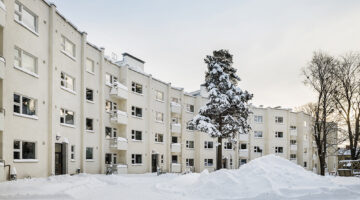
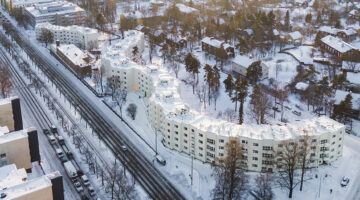
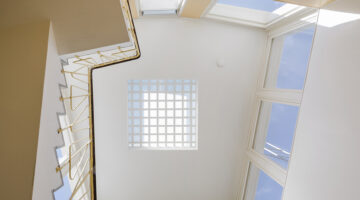
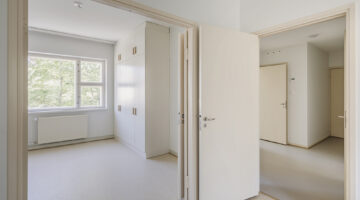
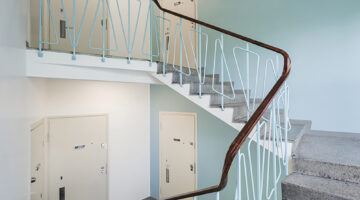

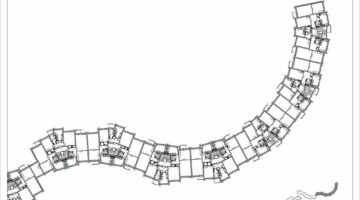
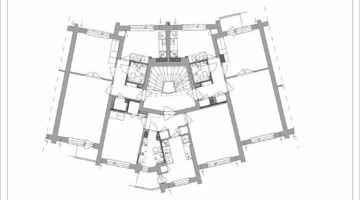

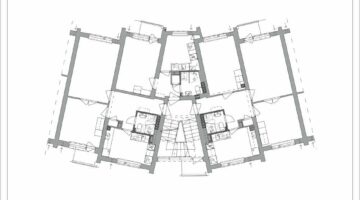

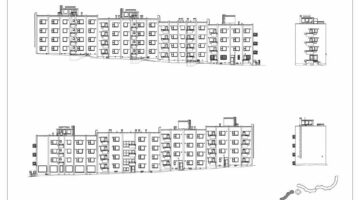
Serpentine House Refurbishment
Main objectives of the project
The Serpentine House is one of the best-known residential developments from the post-war years in Finland and listed by DOCOMOMO Finland as a significant example of modern architecture. The aim of the refurbishment project has been to preserve and enhance the building´s architectural values while solving multiple technical and functional issues.
Date
- 2020: Construction
Stakeholders
- Architect: Marica Schalin
- Architect: Kristina Karlsson
- Architect: Mona Schalin
Location
City: Helsinki
Country/Region: Finland
Description
The long, undulating, four storey tenant block, with its 189 rental flats, is situated on a hilly site at the edge of an garden city area. The courtyards have been redesigned preserving the sylvan character.
The flats consist mainly of two rooms, kitchenette and bathroom. They have been upgraded with special attention to bathrooms, fixtures and fittings. The original kitchen cabinets have been repaired when possible.
Common facilities have been refurbished.
The roof slab has been replaced by a ventilated construction. The exterior rough plastering and balconies with their delicate railings have been reconstructed. Windows and balcony doors have been repaired and any details in poor condition have been replaced. The original colour scheme has been reconstructed in collaboration with a conservator, applying traditional paint methods.
The long road from preliminary condition surveys to successful completion of construction can be seen as a didactic example of a process with many stakeholders involved. Not least because of the specific challenges concerning the conservation of modern architecture.
By 2010, the exterior and the dwellings had long suffered from lack of funding for maintenance. Rejecting the initial renovation programme, based on purely technical and functional priorities, the building permit authorities demanded focus on architectural values. Eventually, the Serpentine House, both buildings and site, were protected in a detailed town plan.
Since the protection had established strict boundaries for intervention, preserving the original architectural, spatial and material characteristics clearly emerged as an objective shared by the client, the authorities and the design team, even as the task was to solve serious technical and structural problems and introduce functional improvements.
The implementation was planned in two stages, the first stage serving as a test lab for the methods and practices during the four years of construction.
The main improvement issues have been the technical performance of the roof and the external walls, built of brick and Betocel blocks. The balconies from a time when steel was scarce, have been rebuilt. The ventilation duct system has been renovated.
The Serpentine House has received publicity as a model for sustainable renovation - the original wooden windows and kitchen cupboards have been repaired with carpenters´skills, the natural ventilation has been improved, the tenants have been able to return to their flats after the construction, the common facilities and the courtyards have been improved.
The future lifespan of the 70 years old buildings has now been secured. The lasting features are the loadbearing structure, the building envelope and the floor plan, while roofing, ventilation, plastered and painted surfaces, fixtures, cupboards, windows etc. will require maintenance according to an appropriate plan. Fortunately, Helsinki City Housing Company has an expertise in dealing with the maintenance of a huge amount of buildings from the 20th century.
